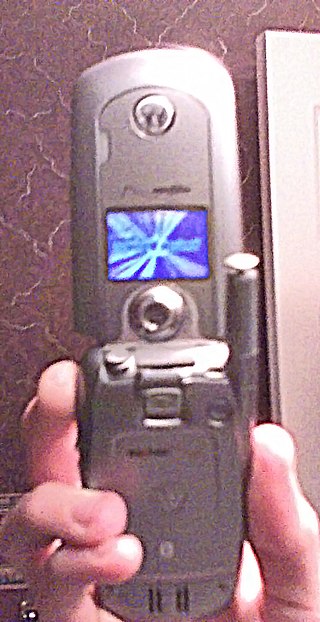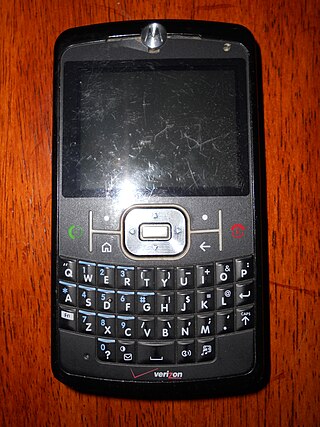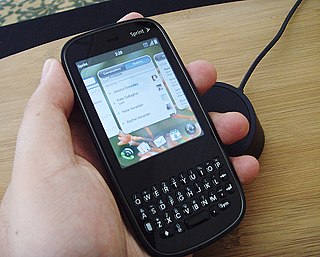The Motorola MPx200 smartphone was launched in December 2003 as a joint venture between Motorola and Microsoft. The mobile phone's Windows Mobile for Smartphone OS allows users to access email and the Internet, use MSN Messenger, and view documents in Microsoft Office formats much like other Windows smartphones such as the Samsung SGH-i600 or HTC Tanager. The MPx200, along with the Samsung SCH-i600, were the first Windows Mobile smartphone devices to have wide distribution in the United States. Previously, smartphone platform devices could only be purchased in the United States as part of development kits sold by Microsoft. The only U.S. carrier of the phone was AT&T Wireless; however, reports also suggest a somewhat limited number of devices with Cingular branding have appeared following the purchase of AT&T Wireless by Cingular.
The Motorola ROKR, the first version of which was informally known as the iTunes phone, was a series of mobile phones from Motorola, part of a 4LTR line developed before the spin out of Motorola Mobility. ROKR models were released starting in September 2005 and ending in 2009. They were notable for incorporating support of media player features.
The Palm Treo 700w is a Windows Mobile-powered smartphone that was officially announced on September 26, 2005. As Palm's first Windows Mobile-powered Treo, the 700w offered an alternative for users who want or need to use Microsoft software. It was offered by Verizon Wireless, and other CDMA carriers. A newer version of this phone has been released, the Treo 700wx.

The HTC Apache is a Windows Mobile 5.0 device, sold as the PPC-6700 by Sprint, and the XV6700 by Verizon Wireless and other US carriers. The device was one of the first CDMA Windows Mobile 5.0 devices on the market, and the first to be released in the United States. The Apache is a Pocket PC PDA with smartphone capabilities.

The Motorola E815 is a clamshell mobile phone that is the successor to the V710. It includes the following features:

The Palm Treo 700p is a cell phone with advanced capabilities, commonly referred to as a smartphone. Unlike the slightly earlier Treo 700w, this model is based on Palm OS. This is the first Palm OS-based Treo model to feature high-speed cellular network support, and is also the first Treo model to support Bluetooth 1.2.
Motorola Krzr, known as the "Canary" before its release, is a series of clamshell/flip mobile phones by Motorola, and was one of the series in the 4LTR line. It consisted of the K1 (2006) followed by the K3 (2007). As a clamshell/flip phone, the Krzr is longer but narrower than the Motorola Razr V3.
Motorola Rizr is a series of slide mobile phones from Motorola, and is one of the series in the 4LTR line. The first model was released in late 2006. It is a sliding phone, where the numeric keys are hidden beneath the screen of the phone when closed.

The Palm Treo 700wx is a smartphone offered by Sprint, Alltel and Verizon as an update to Palm's earlier release of the Verizon-only Treo 700w. It is Palm's second Windows Mobile Treo.
The Motorola Slvr is a former series of candybar mobile phones from Motorola, and was one of the series in the 4LTR line. The first phones were released in early 2005. Inspired by the Razr, they were designed to be very thin and lightweight.

The Motorola Q9c was a smartphone first released in 2007. Initially released as an upgrade to Motorola's Q Series, the Q9C contained a Windows Mobile 6 operating system, push email and instant messaging capabilities, a 1.3 megapixel camera, stereo sound, as well as Bluetooth and GPS navigation.

The HTC Touch Pro is a smart phone from the Touch series of Internet-enabled Windows Mobile Pocket PC smartphones designed and marketed by HTC Corporation of Taiwan. It is an enhanced version of the HTC Touch Diamond with the addition of a left-side slide-out QWERTY keyboard, a microSD card slot, and a camera flash. The Touch Pro smartphone's functions include those of a camera phone and a portable media player in addition to text messaging and multimedia messaging. It also offers Internet services including e-mail, instant messaging, web browsing, and local Wi-Fi connectivity. Depending on its market, it is a quad-band GSM or quad-band UMTS phone with GPRS, EDGE, UMTS, HSDPA, and HSUPA or a tri-band CDMA phone with 1xEV-DO Rev A. All versions feature TouchFLO 3D — a new enhanced version of the TouchFLO interface, unique only to the latest Touch series. In March 2009, HTC announced a new version, the Touch Pro2 which has a larger screen (3.6") and a redesigned slide out QWERTY keyboard with spaces between the keys.

The Samsung SGH-i900, also known as Omnia I or WiTu, is a smartphone created by Samsung Mobile. Announced in June 2008, the Omnia was launched in Singapore in mid-June, available in stores on the 20th of June, and in the rest of Asia in July. For some parts of Europe, it was launched in August. It was made available for the United States in December 2008 through Verizon Wireless and for Canada in April 2009 through Telus Mobility.

The BlackBerry Tour is a consumer smartphone developed by BlackBerry Limited and is part of the 9600 device series. This high-end messaging phone combines the multimedia features of the Curve with the global roaming of the 8830, plus a higher-resolution display, 3.2 megapixel auto-focus camera, overseas 3G data and faster EVDO Rev. A data in the United States and Canada. Other key features include voice calling, video capture, a 3.5mm audio jack, a microSD slot, push email, a QWERTY keyboard, Bluetooth, and GPS navigation. The BlackBerry Tour was released on July 12, 2009. In 2010, the 'Tour 2' refresh was re-branded as the Blackberry Bold 9650 when RIM decided to merge the GSM and CDMA2000 variants under the same brand.

Kin was a short-lived mobile phone line from Microsoft designed for users of social networking. The phones, aimed at people between ages 15 and 30, were manufactured by Sharp Corporation and sold through Verizon Wireless.

The Palm Pixi and Pixi Plus are multimedia smartphones, developed by Palm, which was purchased in 2010 by HP. The device is viewed as a successor to the Palm Centro smartphone and was Palm's second webOS device, after the Palm Pre.

The Motorola A910 is a clamshell mobile phone from Motorola, which uses MontaVista Linux as the operating system.

The Motorola Droid Bionic is an Android-based, 4G LTE-capable smartphone designed by Motorola. It was originally scheduled for release in Q2 2011 but was delayed, eventually being released on 8 September 2011.

The Nokia Lumia 820 is a smartphone designed, developed and marketed by Nokia. It is the successor to the Lumia 800 and is one of the first Nokia phones to implement Windows Phone 8 alongside the Nokia Lumia 920. Although sharing a similar appearance with the Lumia 800, the Lumia 820 is a major overhaul over its predecessor, sporting a 4.3 inches (110 mm) diagonal OLED display with scratch resistant glass, though lacking Gorilla Glass protection, 1.5 GHz dual-core processor, and an 8.7-megapixel camera. The phone will come with LTE connectivity and a wireless-charging option. The 820 is the first Nokia Windows Phone OS based smartphone to embed a microSD card slot.

The Moto X Style is the flagship third-generation of Moto X Android smartphone developed and manufactured by Motorola that was released on September 2, 2015.














